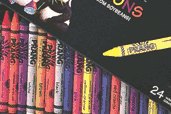Soy crayons
 Investments in research by the soybean industry have enabled important innovations to take place. One of these inovations is the soy crayon. Crayons have always been made with petroleum-based parrafin wax. In 1993, two students at Perdue University created soy crayons as their entry in a Soybean Innovation contest. Dixon-Ticonderoga purchased the rights to the production process of soy crayons.
Investments in research by the soybean industry have enabled important innovations to take place. One of these inovations is the soy crayon. Crayons have always been made with petroleum-based parrafin wax. In 1993, two students at Perdue University created soy crayons as their entry in a Soybean Innovation contest. Dixon-Ticonderoga purchased the rights to the production process of soy crayons.In 1997 the first soy crayons were introduced by Dixon-Ticonderoa. These crayons are made of 85 % soybean oil. In standard crayons the main component are derivates form petroleum oil. They can now be bought in the main supermarkets (mainly in the US).
Soy crayons have the following advantages:
- Soy crayons are easier to use: they glide smoother and don't flake.
- The colours of the soy crayons are brighter.
- They are safer for children (less toxic).
- Soy crayons are better for the environment. Soy crayons are completely biodegradable and are made from renewable resources.